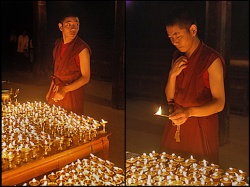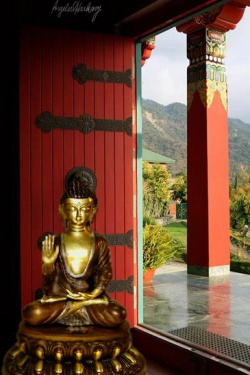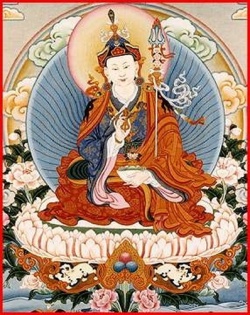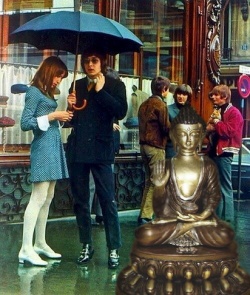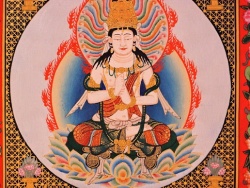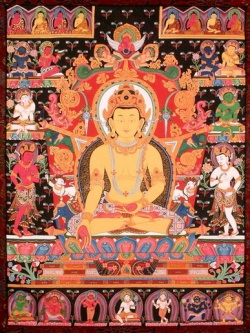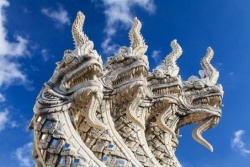Commentaries on the Tibetan Book of the Dead
Here you can read the commentaries of highly respected Buddhist Lama Chögyam Trungpa Rinpoche on the Tibetan Book of the Dead, otherwise known as Bardo Thödol. Though written in 70-s, his commentaries are highly appreciated and recommended as very authoritative by many teachers of Tibetan Buddhism until this day.
What actually represent Tibetan Book of the Dead?! It is a traditional book in Tibetan Buddhism describing in detail the states of mind, otherwise called Bardo, and experiences closely tied with them, which follows after the physical death of a person and shortly before the passing away. It tells how to prepare oneself psychologically to death and the Bardo after death.
How do we know what exactly follows the death?! – Well, we know well enough, if wish to know and we can deny anything, if we wish….
Tibetan culture has been living in close relationships with death and after-death experience for many generations. There are a number of highly realized, Enlightened Tibetan Lamas who are constantly taking rebirth and can tell a lot about their previous lives and intermediate states and so on. There are a number of persons, who have returned from death-like states and can tell their experience. What is more interesting - there is a special practice in Tibetan Buddhism called Phowa or “Conscious dying” through which many thousands of Buddhists, both in Eastern and Western world, have learned what happens after their consciousness leaves the body in their own experience.
Of course, experience is experience, and it is afterwards when we describe our feelings and states of mind to others, and most usually we do it in the language and symbols and notions easily recognized by our listeners. Since Tibetan Book of the Dead was written in Tibet, by Buddhists and for Buddhists – it is a story about meeting with Buddhas and recognizing our Buddha nature in the states after death.
But – death is a death – nobody owns it – it comes to Buddhists and Christians and Hindu, to rich and poor, to small and big. While we hold that the after-death experiences as described in the Tibetan Book of the Dead are true for everyone, we gladly allow that in some other cultures and religions similar experiences may be described differently.
The author of the following commentaries, Chögyam Trungpa Rinpoche (February 28, 1939 – April 4, 1987) was a highly recognized Buddhist master and Tulku, both in Kagyu and Nyingma lineages, one of the first teachers of Tibetan Buddhism in the West, first in Scotland and later in USA from 1970-1987, author of many books on Buddhism.
Ven. Chögyam Trungpa was a Buddhist and Bodhisattva and we have reasons to believe it would be his wish that such important Tibetan teachings concerning living and dying would reach people near and far for the benefit of all beings. The Message of the Tibetan Book of the Dead
Bardo means gap; it is not only the interval of suspension after we die but also suspension in the living situation; death happens in the living situation as well. The bardo experience is part of our basic psychological makeup.
There are all kinds of bardo experiences happening to us all the time, experiences of paranoia and uncertainty in everyday life; it is like not being sure of our ground, not knowing quite what we have asked for or what we are getting into.
So Tibetan Book of the Dead is not only a message for those who are going to die and those who are already dead, but it is also a message for those who are already born; birth and death apply to everybody constantly, at this very moment.
The bardo experience can be seen in terms of the six realms of existence that we go through, the six realms of our psychological states.
Then it can be seen in terms of the different deities who approach us, as they are described in the book:
In the first week the peaceful deities, and in the last week the wrathful deities; there are the five tathagatas and the herukas, and the gauris who are messengers of the five tathagatas, presenting themselves in all sorts of terrifying and revolting fashions.
The details presented here are very much what happens in our daily living situation, they are not just psychedelic experiences or visions that appear after death. These experiences can be seen purely in terms of the living situation; that is what we are trying to work on.
In other words, the whole thing is based on another way of looking at the psychological picture of ourselves in terms of a practical meditative situation.
Nobody is going to save us, everything is left purely to the individual, the commitment to who we are. Gurus or spiritual friends might instigate that possibility, but fundamentally they have no function.
How do we know that these things actually happen to people who are dying? Has anyone come back from the grave and told us the experiences they went through?
Those impressions are so strong that someone recently born should have memories of the period between death and birth;
but then as we grow up we are indoctrinated by our parents and society, and we put ourselves into a different framework, so that the original deep impressions become faded except for occasional sudden glimpses.
Even then we are so suspicious of such experiences, and so afraid of losing any tangible ground in terms of living in this world, that any intangible kind of experience is treated half-heartedly or dismissed altogether.
To look at this process from the point of view of what happens when we die seems like the study of a myth; we need some practical experience of this continual process of bardo.
There is the conflict between body and consciousness, and there is the continual experience of death and birth.
There is also the experience of the bardo of dharmata, the luminosity, and of the bardo of becoming, of possible future parents or grounding situations.
We also have the visions of the wrathful and peaceful divinities, which are happening constantly, at this very moment.
If we are open and realistic enough to look at it in this way, then the actual experience of death and the bardo state will not be either purely a myth or an extraordinary shock, because we have already worked with it and become familiar with the whole thing. The Bardo of the Moment before Death
The first basic bardo experience is the experience of uncertainty about whether one is actually going to die, in the sense of losing contact with the solid world, or whether one could continue to go on living.
This uncertainty is not seen in terms of leaving the body, but purely in terms of losing one’s ground; the possibility of stepping out from the real world into an unreal world.
We could say that the real world is that in which we experience pleasure and pain, good and bad. There is some act of intelligence which provides the criteria of things as they are, a basic dualistic notion.
But if we are completely in touch with these dualistic feelings, that absolute experience of duality is itself the experience of non-duality.
Then there is no problem at all, because duality is seen from a perfectly open and clear point of view in which there is no conflict; there is a tremendous encompassing vision of oneness.
Conflict arises because duality is not seen as it is at all. It is seen only in a biased way, a very clumsy way. In fact, we do not perceive anything properly, and we begin to wonder whether such things as myself and my projections really exist.
So when we talk about the dualistic world as confusion, that confusion is not the complete dualistic world, but only half-hearted, and this causes tremendous dissatisfaction and uncertainty;
it builds up to the point of fear of becoming insane, the point where there are possibilities of leaving the world of duality and going into a sort of woolly, fuzzy emptiness, which is the world of the dead, the graveyard that exists in the midst of fog.
The Tibetan Book of the Dead describes the death experience in terms of the different elements of the body, going deeper and deeper.
Physically you feel heavy when the earth element dissolves into water; and when water dissolves into fire you find that the circulation begins to cease functioning.
When fire dissolves into air, any feeling of warmth or growth begins to dissolve; and when air dissolves into space you lose the last feeling of contact with the physical world.
Finally, when space or consciousness dissolves into the central nādi, there is a sense of internal luminosity, an inner glow, when everything has become completely introverted.
Such experiences happen constantly. The tangible, logical state dissolves, and one is not quite certain whether one is attaining enlightenment or losing one's sanity.
Whenever that experience happens it can be seen in four or five different stages:
First the tangible quality of physical, living logic becomes vague; in other words, you lose physical contact.
Then you automatically take refuge in a more functional situation, which is the water element; you reassure yourself that your mind is still functioning.
In the next stage, the mind is not quite sure whether it is functioning properly or not, something begins to cease operating in its circulation.
The only way to relate is through emotions, you try to think of someone you love or hate, something very vivid, because the watery quality of the circulation does not work any more, so the fiery temperature of love and hate becomes more important.
Even that gradually dissolves into air, and there is a faint experience of openness, so that there is a tendency to lose your grip on concentrating on love or trying to remember the person you love. The whole thing seems to be hollow inside.
The next experience is the luminosity. You are willing to give in because you cannot struggle any more, and a kind of carelessness arises at that moment.
It is as though pain and pleasure are occurring at the same time, or a powerful shower of icy cold water and boiling hot water is pouring simultaneously over your body.
It is an intense experience, very powerful and full, the experience of oneness where both pain and pleasure are the same.
The dualistic struggle of trying to be something is completely confused by the two extreme forces of hope for enlightenment and fear of becoming insane.
The two extremes are so concentrated that it allows a certain relaxation; and when you do not struggle any more the luminosity presents itself naturally.
The next step is the experience of luminosity in terms of daily life. The luminosity is neutral ground or background, a gap when the intensity slackens.
Then some intelligence begins to connect it to the awakened state of mind, leading to a sudden glimpse of meditative experience or Buddha nature, which could also be called the dharmakaya.
But if we have no means of connecting with the basic intelligence, and confused energy still dominates our process of mind, then the energy builds up blindly and finally falls down into different levels of diluted energy, so to speak, from the absolute energy of the luminosity.
Some basic tendency of grasping begins to develop in the state of luminosity, and from that the experience of the six realms of the world develops according to its intensity.
But that tenseness or tightness cannot just function by itself without an activator of energy; in other words, energy is being used in order to grasp.
We can now look at the six realms of the world from the point of view of different types of instinct.
